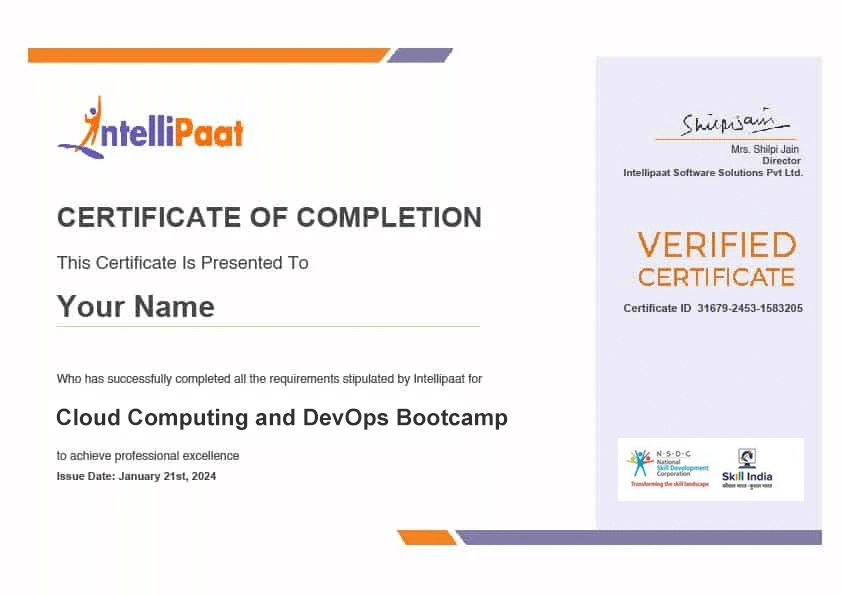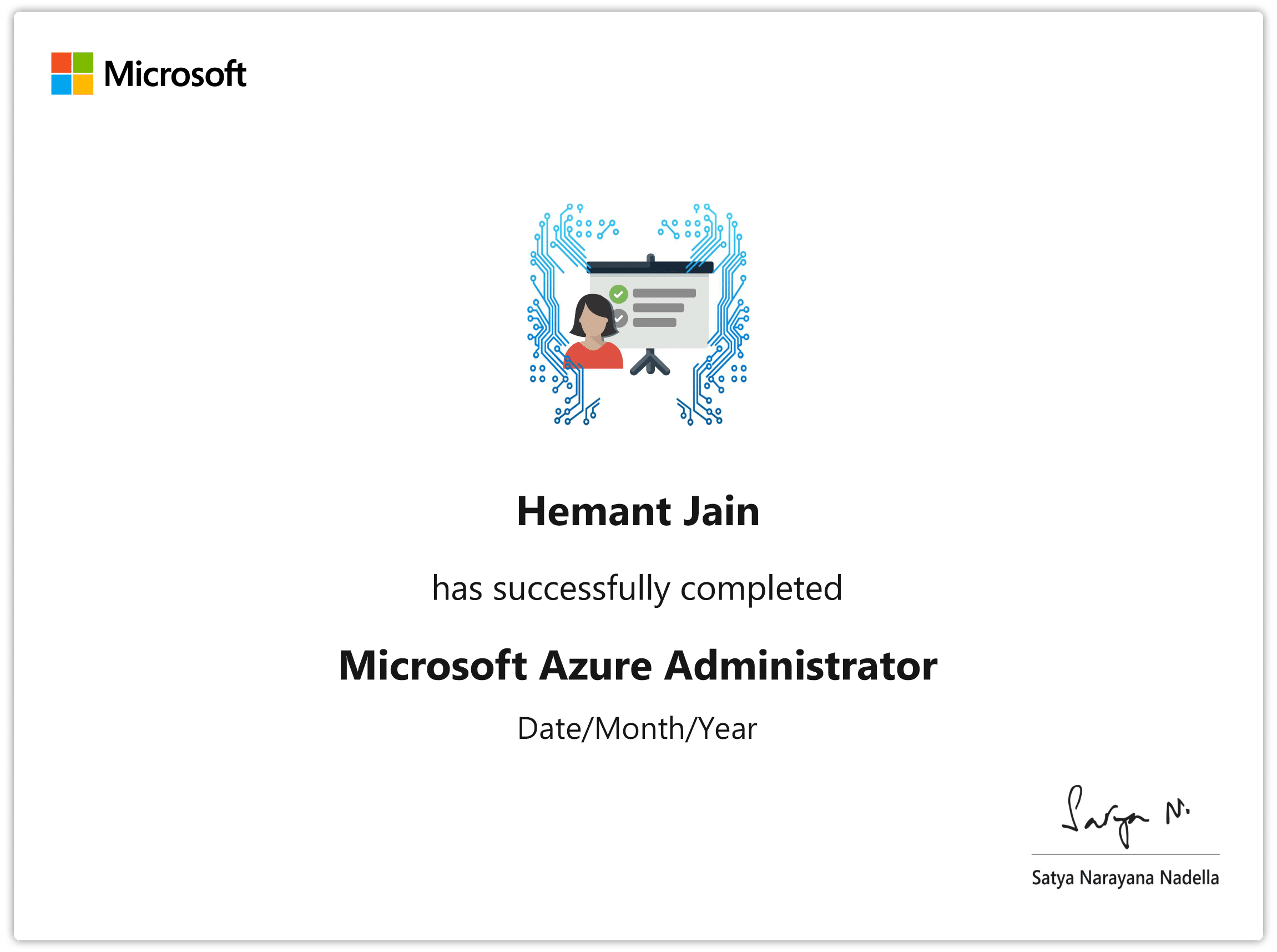Your cart is currently empty.






This course in cloud computing and DevOps with placement services will help you gain proficiency in cloud computing and DevOps. Work on real-life projects and multiple hands-on assignments in AWS, Azure, etc. With this course, you get placement services from Intellipaat for 12 months after course completion and only upon moving to the placement pool by clearing the Placement Readiness Test (PRT). The course will help you become a certified cloud and DevOps architect.


Watch
Course PreviewLearning Format
Online Boot Camp
Live Classes
7 Months
Career Services and
Interview Preparation
Microsoft
Certification
500+
Hiring Partners
This course will provide you with in-depth knowledge of how to build applications in the cloud. This course will help you learn the best practices for deploying SaaS, PaaS, and IaaS applications on AWS, and Azure. Master DevOps tools to automate and improve the overall efficiency and delivery of software applications.
Course Advantage
On completion of this course, you will:
Program in Collaboration with Microsoft
Benefits for students from Microsoft:
59% Average Salary Hike
$1,08,000 Highest Salary
700+ Career Transitions
300+ Hiring Partners
Career Transition Handbook
*Past record is no guarantee of future job prospects
Evaluate the alternatives to cloud computing and prepare a case for the best possible method.
Establish and manage database storage services such as BigQuery, RedShift, NoSQL, and SQL Server.
Design and deliver robust, secure, and innovative cloud computing solutions that will allow the development team to create new applications.
Perform integration using MDM, SIEM vendors, SSO, endpoint security, and PAM.
Design, build, debug, and troubleshoot various software programs for applications, tools, databases, and networks.
Design, develop, and operate the various solutions and products of the cloud computing infrastructure.
Skills to Master
AWS EC2
ELB
Azure
Blobs
Replication
CD
Azure VM
Access Management
DevOps
Docker
Selenium
Maven
Jenkins
Nagios
Python
Lambda Functions
pandas
Linux
Splunk
Tools to Master
Linux
36 Hours 14 Module
PreviewModule 01 – Introduction to Cloud Computing & AWS
Module 02 – Elastic Compute and Storage Volumes
Module 03 – Load Balancing, Autoscaling and DNS
Module 04 – Virtual Private Cloud
Module 05 – Storage – Simple Storage Service (S3)
Module 06 – Databases and In-Memory DataStores
Module 07 – Management and Application Services
Module 08 – Access Management and Monitoring Services
Module 09 – Automation and Configuration management
Module 10 – AWS Migration
Module 11 – Interview Preparation Sessions
Module 11 – Architecting AWS – whitepaper
Module 12 – DevOps on AWS
Module 13 – Amazon FSx and Global Accelerator
Module 14 – AWS Architect Interview Questions
15 Hours 2 Module
33 Hours 11 Module
PreviewModule 01 – Infrastructure Setup
Module 02 – Introduction to DevOps
Module 03 – Version Control with Git
Module 04 – Containerization Using Docker
Module 05 – Configuration Management using Puppet (self-paced)
Module 06 – Configuration Management using Ansible
Module 07 – Continuous Integration with Jenkins
Module 08 – Continuous Orchestration Using Kubernetes
Module 09 – Continuous Monitoring using ELK
Module 10 – Terraform Modules & Workspaces
30 Hours 10 Module
Module 01 – Introduction to Microsoft Azure
Module 02 – Introduction to ARM & Azure Storage
Module 03 – Introduction to Azure storage
Module 04 – Azure Virtual Machines
Module 05 – Azure App and Container services
Module 06 – Azure Networking – I
Module 07 – Azure Networking – II
Module 08 – Authentication and Authorization in Azure using RBAC
Module 09 – Microsoft Azure Active Directory
Module 10 – Azure Monitoring
Module 11 – Interview Preparation Sessions
36 Hours 14 Module
Module 1 – Introduction to Microsoft Azure
Module 2 – Introduction to ARM & Azure Storage
Module 3 – Introduction to Azure storage
Module 4 – Azure Virtual Machines
Module 5 – Azure App and Container Services
Module 6 – Azure Networking
Module 7 – Azure Networking – II
Module 8 – Authentication and Authorization in Azure using RBAC
Module 9 – Microsoft Azure Active Directory
Module 10 – Azure Monitoring
Module 11 – Multi-Factor Authentication (MFA)
Module 12 – Migration in Azure
Module 13 – Azure Data Platform – I
Module 14 – Azure Data Platform – II
26 Hours 9 Module
Module 1 – Non-Relational Data Stores and Azure Data Lake Storage
Module 2 – Data Lake and Azure Cosmos DB
Module 3 – Relational Data Stores
Module 4 – Why Azure SQL?
Module 5 – Azure Batch
Module 6 – Azure Data Factory
Module 7 – Azure Data Bricks
Module 8 – Azure Stream Analytics
Module 9 – Monitoring & Security
24 Hours 8 Module
Module 01 – Introduction to Google Cloud
Module 02 – Google Cloud Services
Module 03 – Google Computing Services
Module 04 – Google Storage Services
Module 05 – Google Cloud APIs
Module 06 – Google Networking Services
Module 07 – IAM & Security Services
Module 08 – Migrating to Google Cloud
26 Hours 39 Module
Module 01 – Splunk Development Concepts
Module 02 – Basic Searching
Module 03 – Using Fields in Searches
Module 04 – Saving and Scheduling Searches
Module 05 – Creating Alerts
Module 06 – Scheduled Reports
Module 07 – Tags and Event Types
Module 08 – Creating and Using Macros
Module 09 – Workflow
Module 10 – Splunk Search Commands
Module 11 – Transforming Commands
Module 12 – Reporting Commands
Module 13 – Mapping and Single Value Commands
Module 14 – Splunk Reports and Visualizations
Module 15 – Analyzing, Calculating and Formatting Results
Module 16 – Correlating Events
Module 17 – Enriching Data with Lookups
Module 18 – Creating Reports and Dashboards
Module 19 – Getting Started with Parsing
Module 20 – Using Pivot
Module 21 – Common Information Model (CIM) Add-On
Splunk Administration Topics
Module 22 – Overview of Splunk
Module 23 – Splunk Installation
Module 24 – Splunk Installation in Linux
Module 25 – Distributed Management Console
Module 26 – Introduction to Splunk App
Module 27 – Splunk Indexes and Users
Module 28 – Splunk Configuration Files
Module 29 – Splunk Deployment Management
Module 30 – Splunk Indexes
Module 31 – User Roles and Authentication
Module 32 – Splunk Administration Environment
Module 33 – Basic Production Environment
Module 34 – Splunk Search Engine
Module 35 – Various Splunk Input Methods
Module 36 – Splunk User and Index Management
Module 37 – Machine Data Parsing
Module 38 – Search Scaling and Monitoring
Module 39 – Splunk Cluster Implementation
Projects will be a part of your Cloud & DevOps Architects Master’s course to consolidate your learning. It will ensure that you have real-world experience in cloud and DevOps.

Admission Details
The application process consists of three simple steps: An offer of admission will be made to selected candidates based on the feedback from the interview panel. The selected candidates will be notified over email and phone, and they can block their seats through the payment of the admission fee.
Submit Application
Tell us a bit about yourself and why you want to join this program
Application Review
An admission panel will shortlist candidates based on their application
Admission
Selected candidates will be notified within 1–2 weeks
Total Admission Fee
Admissions are closed once the requisite number of participants enroll for the upcoming cohort. Apply early to secure your seat.
| Date | Time | Batch Type | |
|---|---|---|---|
| Program Induction | 16th Nov 2024 | 10:00 AM - 01:00 PM IST | Weekend (Sat-Sun) |
Others Cohorts
| Date | Time | Batch Type | |
|---|---|---|---|
| Program Induction | 16th Nov 2024 | 08:00 PM - 11:00 PM IST | Weekend (Sat-Sun) |
Intellipaat’s job opportunity course in cloud computing and DevOps has a structured learning path specially designed by industry experts, which ensures that you can become a cloud and DevOps expert. If you want to pursue a master’s in cloud computing online, then this course is for you.
On completion of all the required assignments, case studies, quizzes, and project work you will graduate from the course and you will receive your certification.
According to Glassdoor, the average annual salary of a certified cloud architect in India is ₹8,00,000
There are over 56,000+ cloud architect jobs in the United States listed on LinkedIn. While India has over 7,000 cloud architect job opportunities listed on LinkedIn.
No, you don’t need any programming knowledge to start with this course.
The following are some of the companies that are actively hiring cloud architects:
You will get the opportunity to work on multiple projects and assignments, which will provide you with real-world industry exposure. At the end of the course, you will work on a capstone project as well, which has a research element, and you can showcase the same to top companies to get hired.
Following are some of the certification exams that you will be able to easily clear if you complete our course:
Candidates must clear the PRT ( Placement Readiness Test) after the course completion to get into the placement pool and get access to our job portal as well as the career mentoring program. Placement opportunities will be provided to those candidates who made it to the placement pool. Once candidates move to the placement pool, career services will be offered for 12 months after course completion.
To be eligible for this course, you will need to meet the following criteria:
The cloud computing market is expected to grow by 35% in 2022, which would generate many opportunities for cloud computing professionals.
The course duration is 7 months.
The course will go on for 7 months, along with live classes, assignments, case studies and project work. To effectively understand the topics and grasp the concepts, candidates are required to devote 10 hours per week or more as per your learning curve. This will also help with better preparation for the job interviews.
You can always reach out to our support team. Additionally, you will be assigned dedicated teaching assistants who will also be available, apart from your instructors, for doubt clearance.
The trainers for this course are leading industry experts with tremendous knowledge in the field.
We value the candidates who wish to learn but do not have the financial bandwidth to make an upfront payment of the fees. Hence, Intellipaat offers an easy, no-cost EMI option to the candidates.
All the sessions at Intellipaat are recorded and will be available to the learners within 12 hours after the session. If, by any circumstance, you missed the live class, you can go through the recordings. Also, if you need any support, you will have access to 24*7 technical support for any sort of query resolution.
Due to any reason you want to defer the batch or restart the classes in a new batch then you need to send the batch defer request on [email protected] and only 1 time batch defer request is allowed without any additional cost.
Learner can request for batch deferral to any of the cohorts starting in the next 3-6 months from the start date of the initial batch in which the student was originally enrolled for. Batch deferral requests are accepted only once but you should not have completed more than 20% of the program. If you want to defer the batch 2nd time then you need to pay batch defer fees which is equal to 10% of the total course fees paid for the program + Taxes.
Yes, Intellipaat certification is highly recognized in the industry. Our alumni work in more than 10,000 corporations and startups, which is a testament that our programs are industry-aligned and well-recognized. Additionally, the Intellipaat program is in partnership with the National Skill Development Corporation (NSDC), which further validates its credibility. Learners will get an NSDC certificate along with Intellipaat certificate for the programs they enroll in.
What is included in this course?
 Click to Zoom
Click to Zoom
 Click to Zoom
Click to Zoom











































